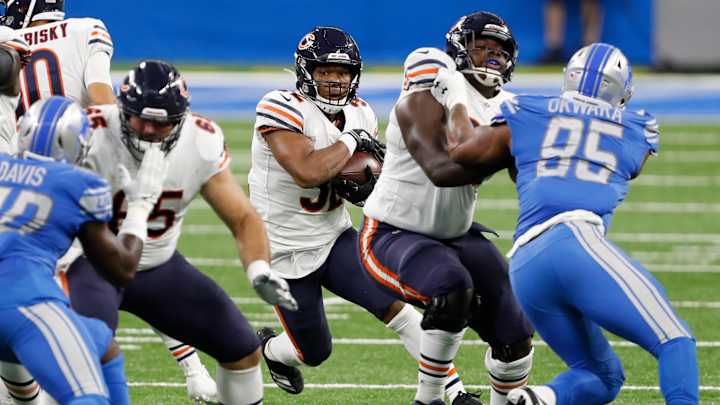Running Game Refit: Bears Enjoy Benefits of New Approach

Matt Nagy finally has the running game he always wanted.
It might not be out of the shotgun as the Bears tried running all last year and the attempt totals might need to increase overall, but the running game is the way Nagy originally envisioned with a back-by-committee approach.
"We feel like, all three running backs, when you get that running game going first it does wonders for our confidence," running back Tarik Cohen said.
Sure, David Montgomery had the majority of carries against the Detroit Lions in the season-opening 27-23 victory. They still had productivity from Cohen and Cordarrelle Patterson and made it look like that committee approach Nagy said he wanted back in the offseason between 2018 and 2019.
It finally all worked after the offseason redesign accomplished in collaboration with offensive line coach Juan Castillo and offensive coordinator Bill Lazor. The end result was an attack that set up the play-action passing style quarterback Mitchell Trubisky says he enjoys.
"Again, like, sometimes somebody gets a hot hand, and if that's the case then maybe somebody gets a little bit more based off of who they are and how they run the ball," Nagy said. "That's the part that in the end is probably the hardest thing to judge as to how you do that when you're dealing with those guys."
The productivity was good across the board and it's something the Bears can hope to accomplish against the Giants Sunday, after New York gave up 141 yards rushing to Pittsburgh in its opener.
It's not often in an NFL game when three different backs can register long runs of 10 yards or more but the Bears did it and set up their passing game later by accomplishing it. Montgomery had a 10-yarder, Patterson a 13-yard run and Cohen a 16-yard run. They even achieved a fourth 10-plus run when Trubisky scrambled for 20 during the comeback.
"I feel like it builds confidence within the offense, the play-calling and also the individual groups like the O-line and the running backs," Cohen said. "Just having those 16-yard runs, 10-plus yard runs and almost having a 6-yard average in the rushing game, it makes the play caller comfortable calling anything, calling a run on first, second or third down.
"It just gives us the ability to be mysterious in the play-calling and not be one-dimensional."
Montgomery had 13 rushes for 64 yards, Cohen seven runs for 41 and Patterson four for 19 yards. The rushing attempt totals might seem low, but Nagy pointed out they equate to more carries in different game circumstances—like, if they weren't losing by 17 points at the start of the fourth quarter.
"Where those numbers will jump up is you hope to be in four-minute mode instead of two-minute mode," Nagy said. "Now all of a sudden, Montgomery goes to 18 carries. Maybe he's at 16 and he goes to 20 carries because you're in four-minute mode."
It helps to be killing clock on the ground rather than running an offense in panic mode, trying to make up a deficit with passes.
"I think last year, if the numbers are right, well actually in four quarters, I think 35 led the league, 35 attempts," Nagy said. "That's meaning with four-minute, with the Ravens. And I think the 49ers were about 30 rush attempts per game, was No. 2 in the NFL, rush attempts. We were at 28 last week. Now there's a couple scrambles in there with the QB."
The contribution by Castillo went beyond helping with play design. He had to have the offensive line actually execute the run blocks, which hasn't been a strength in recent years. The Bears gave up one sack and opened the way for a 5.2-yard average from their backs.
Castillo cited the fundamentals he constantly preaches.
"It's about doing something over and over," he said, sounding a familiar refrain from offseason. "The time that those guys have put in before practice and I think that’s the reward that they get from watching the tape when they watch the tape (afterward). The footwork, being able to finish, their hat placement, their hand placement, all those things are things that they’re really working .
"The guys came off the football. They finished the plays. And that made them physical."
Twitter: BearDigest@BearsOnMaven
